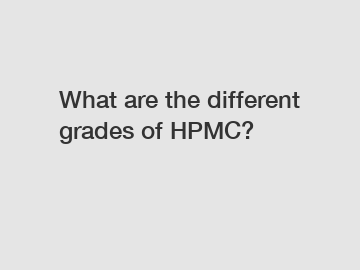What are the different grades of HPMC?
What are the different grades of HPMC?
Hydroxypropyl methylcellulose (HPMC) is a versatile polymer derived from cellulose. It finds extensive use in various industries due to its unique properties and functionalities. However, different applications require different grades of HPMC, each with distinct characteristics. In this article, we will explore the different grades of HPMC and their specific applications.
1. Construction Grade HPMC:

Construction grade HPMC is primarily used in the construction industry. It acts as a thickener, water retention agent, and bonding agent in various cementitious materials, such as tile adhesives, dry mix mortars, and self-leveling compounds. This grade of HPMC ensures improved workability, enhanced strength, and excellent adhesion in these construction materials.
2. Pharmaceutical Grade HPMC:
Pharmaceutical grade HPMC, also known as hypromellose, is a vital ingredient in the pharmaceutical industry. It is widely utilized as a binder, film-former, and controlled-release agent in oral solid dosage forms. This grade of HPMC ensures proper tablet integrity, controlled drug release, and improved patient compliance. Additionally, it also finds use in ophthalmic formulations as a lubricant to alleviate dry eye symptoms.
3. Food Grade HPMC:
Food grade HPMC is widely employed as a food additive in the food industry. Due to its non-toxic nature, it is utilized as a thickener, emulsifier, and stabilizer in various food products. Food grade HPMC enhances the texture and quality of processed foods, including sauces, bakery products, and dairy products. It ensures improved shelf life, texture, and mouthfeel of these food items.
4. Cosmetic Grade HPMC:
Cosmetic grade HPMC plays a significant role in the formulation of personal care and cosmetic products. It acts as a suspending agent, thickener, and binder in skincare products, hair care products, and lotions. This grade of HPMC enhances the stability, rheological properties, and aesthetic appeal of cosmetic formulations. It provides excellent moisturization, film-forming properties, and skin-soothing effects.
In conclusion, the different grades of HPMC cater to diverse industries and applications. Construction grade HPMC ensures better workability, adhesion, and strength in cementitious materials. Pharmaceutical grade HPMC serves as a binder, controlled-release agent, and lubricant in various pharmaceutical formulations. Food grade HPMC acts as a food additive, improving the texture, stability, and quality of processed foods. Lastly, cosmetic grade HPMC enhances the stability, rheological properties, and aesthetic appeal of personal care and cosmetic products.
Whether it's making construction materials more effective, enhancing drug delivery, improving food products, or enhancing the efficacy of personal care items, the distinct grades of HPMC offer tailored solutions across industries. As researchers continue to explore its potential, HPMC will undoubtedly keep playing a crucial role in various sectors, contributing to the advancement and innovation of numerous products and processes.
For more information, please visit gypsum retarder manufacturer, gypsum retarder chemical, gypsum retarder manufacturer.


